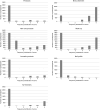Associations of concentrations of eight urinary phthalate metabolites with the frequency of use of common adult consumer and personal-care products
- PMID: 38431676
- PMCID: PMC10908856
- DOI: 10.1038/s41598-024-55929-2
Associations of concentrations of eight urinary phthalate metabolites with the frequency of use of common adult consumer and personal-care products
Abstract
This study analyzed the relationship between urine concentrations of phthalate metabolites (UCOM) and personal care products (PCPs) used in adults and examined the change in UCOM according to the usage frequency of PCPs based on raw data from the 3rd Korean National Environmental Health Survey conducted between 2015 and 2017. The relationship between PCP use frequency and UCOM was analyzed using multiple regression analysis, adjusting for baseline factors. The regression model consisted of a Crude Model with log-transformed UCOM before and after adjustment for urine creatinine concentrations. Model 1 was additionally adjusted for age, sex, and obesity, while Model 2 was additionally adjusted for smoking, alcohol consumption, pregnancy history, average monthly income of the household, and PCP exposure within the past 2 days. PCP usage frequency was significantly associated with the UCOM without adjustment for urine creatinine and correlated with demographic characteristics, urine creatinine concentration, and PCP exposure within the past 2 days. This study on exposure to urinary phthalates will play a crucial role in Korean public health by aligning with the fundamentals of research priorities and providing representative data on phthalate exposure for conducting population-level studies.
Keywords: Biological sample; Cosmetics and air fresheners; Phthalates; Urine creatinine.
© 2024. The Author(s).
Conflict of interest statement
The authors declare no competing interests.
Figures
References
-
- Meeker JD, Ferguson KK. Relationship between urinary phthalate and bisphenol A concentrations and serum thyroid measures in U.S. adults and adolescents from the national health and nutrition examination survey (NHANES) 2007–2008. Environ. Health Perspect. 2011;119:1396–1402. doi: 10.1289/ehp.1103582. - DOI - PMC - PubMed
-
- Furtmann K. Phthalates in surface water—A method for routine trace level analysis. Fresenius J. Anal. Chem. 1994;348:291–296. doi: 10.1007/BF00324037. - DOI
MeSH terms
Substances
LinkOut - more resources
Full Text Sources
Medical
Miscellaneous



